Researchers have uncovered evidence suggesting human activity in Argentina dating back 21,000 years, potentially reshaping our understanding of early human migration in the Americas. The study, published in PLOS ONE, analyzes cut marks on fossilized remains of a giant armadillo-like creature, indicating possible butchery by early human inhabitants.
Unveiling Ancient Butchery Techniques
The research team, led by Mariano Del Papa from the National University of La Plata, examined fossils of a Neosclerocalyptus, a giant relative of modern armadillos, found along the banks of the Reconquista River in Argentina’s Pampean region. Using statistical analysis, they determined that marks on the creature’s pelvis, tail, and body armor were consistent with those made by stone tools.
The placement of these marks aligns with a butchering sequence targeting areas of dense flesh, suggesting intentional and skilled processing of the animal. Radiocarbon dating places these fossils at approximately 21,000 years old, making them nearly 6,000 years older than other known archaeological evidence in southern South America.
Miguel Delgado, the study’s corresponding author, emphasizes the significance of these findings: “The study’s evidence puts into question the time frame for the first human peopling of the Americas 16,000 years ago.”
Implications for Early Human Migration
This discovery adds to a growing body of evidence challenging the traditional timeline of human migration into the Americas. The long-held belief that humans first arrived in the Americas around 16,000 years ago has been increasingly contested in recent years.
These findings not only push back the date of human presence in South America but also provide insight into early human interactions with now-extinct megafauna. The Neosclerocalyptus was part of a diverse group of large mammals that roamed the Americas during the Pleistocene epoch, many of which became extinct around 11,000 years ago.
The study suggests a potential link between human arrival and megafaunal extinctions, a topic of ongoing debate in paleontology and archaeology. However, the researchers caution that more evidence is needed to draw definitive conclusions about this relationship.
Why it matters: This research has significant implications for our understanding of human prehistory in the Americas. If confirmed, it would substantially alter the timeline of human migration and settlement in South America, pushing back the date of arrival by thousands of years. This, in turn, could impact theories about the routes and methods of early human dispersal across the continent.
Moreover, the study provides valuable insights into early human adaptations and survival strategies in a new environment. The ability to hunt and process large mammals like the Neosclerocalyptus would have been crucial for the survival and spread of early human populations in South America.
However, several questions remain. How widespread was human presence in South America at this time? What routes did these early settlers take to reach Argentina? And how did their presence impact the local ecosystem and megafauna populations?
The researchers suggest that further excavation at the site, more extensive radiocarbon dating, and additional analysis of the cut marks could provide more conclusive evidence. They also emphasize the need for similar studies in other parts of South America to build a more comprehensive picture of early human migration and settlement patterns.
As new technologies and methodologies continue to emerge, our understanding of human prehistory is constantly evolving. This study demonstrates the potential for new discoveries to challenge established theories and open up new avenues of research in the fields of archaeology and paleoanthropology.
If our reporting has informed or inspired you, please consider making a donation. Every contribution, no matter the size, empowers us to continue delivering accurate, engaging, and trustworthy science and medical news. Independent journalism requires time, effort, and resources—your support ensures we can keep uncovering the stories that matter most to you.
Join us in making knowledge accessible and impactful. Thank you for standing with us!

